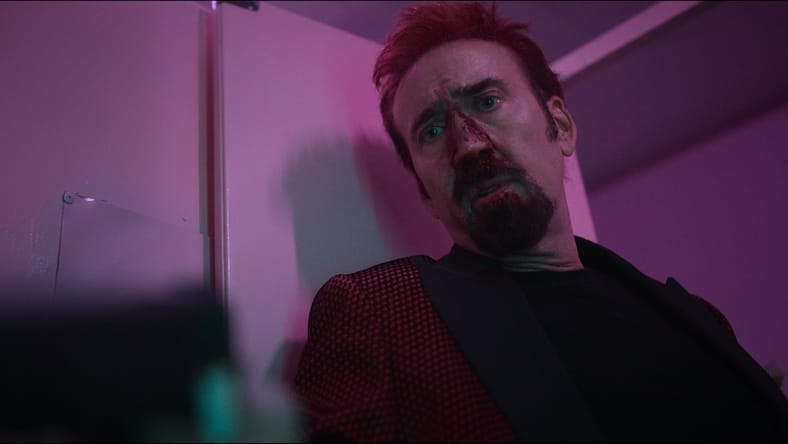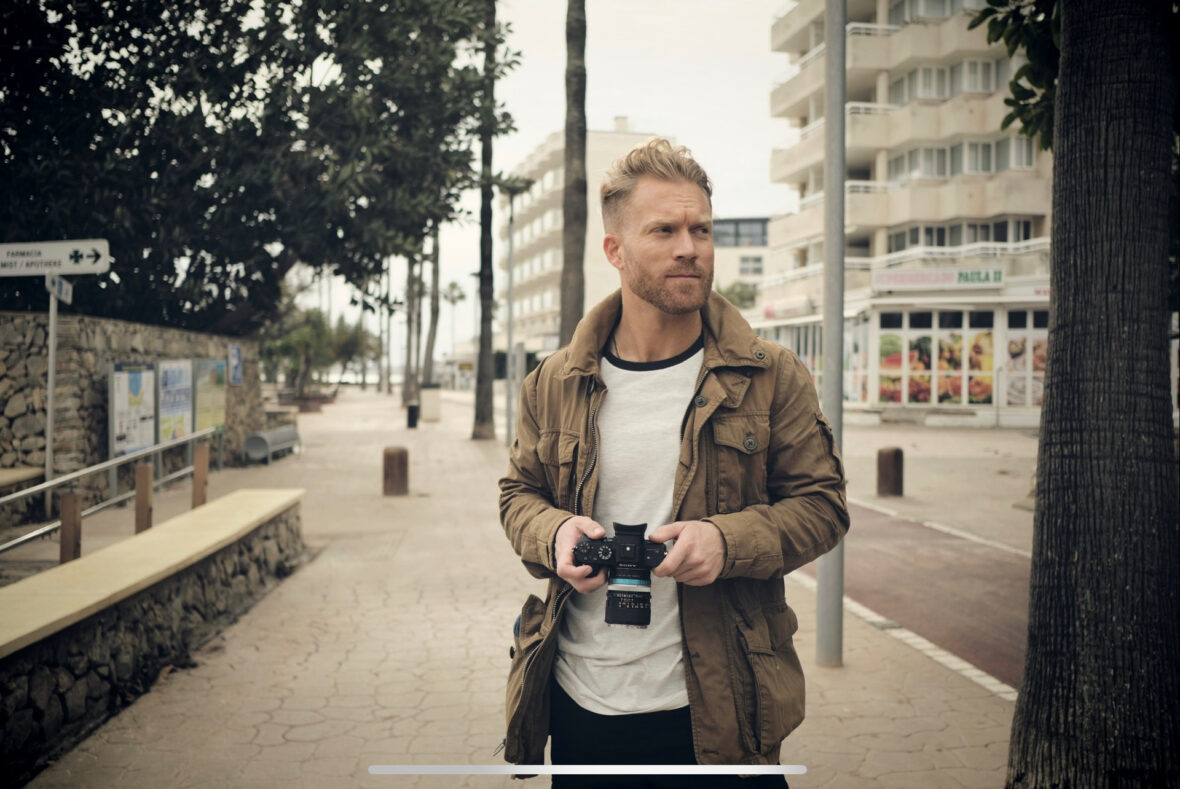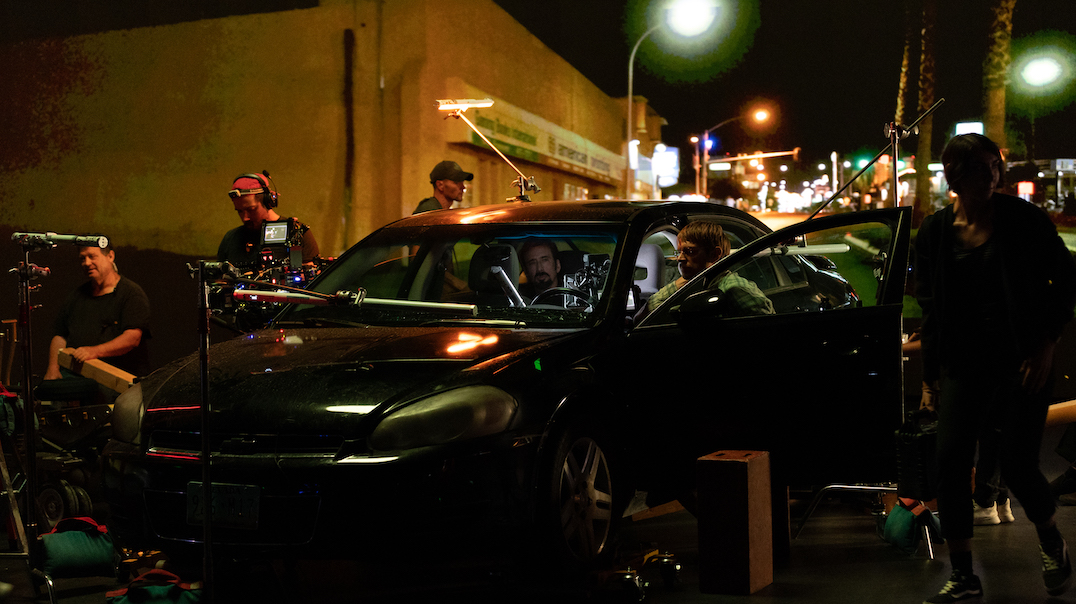
Sympathy for the Devil tells the story of a red-haired, demonic carjacker played by Nicolas Cage who takes a family man played by Joel Kinnaman hostage just as his wife is about to give birth. A huge section of it takes place in the dad’s car — a challenge that delighted cinematographer Steven Holleran.
He recognized the film’s color schemes as one of the most effective ways he could keep audiences rapt through a hellish car ride through the outskirts of Las Vegas.
“Your biggest challenge of the movie is the car. That set is always challenging to shoot, whether you’re doing it on a trailer, or you’re doing it on a stage. It’s a big challenge, and a big conceit, if you’re doing it for 40 or 50 minutes of a movie, like we were. We knew it had to be authentic. We knew it had to be interesting. We knew it had to play strongly enough that the audience wouldn’t fall out of watching these two actors talk to each other in a car, because it could get really slow, quick, and the visuals can get dull.”
It doesn’t. The film maintains an ambiance of ambiguity and mystery through its final minutes, with a simmering sense of menace augmented by Holleran’s choices, especially around color and shadow.
“There’s this conflict of good and evil, and truth and fiction. And that interplays between these two characters… you don’t know where they stand for most of the movie. And so I fell in love with this idea of communicating that unknown. And the grey that that lives between, say, right and wrong or good and evil, with color,” he says in the latest MovieMaker podcast, which you can check out on Apple or Spotify:
“I thought, OK, well, you have your traditional red as evil and it’s also ‘stop’ for driving, and this is a car movie. And then you have green for good and ‘go.’ Traditionally, I thought, OK, well, what about all the colors in the middle?” Holleran adds.
“Let’s give this a kaleidoscope feeling. And that’s where purples and magentas and fuchsias and blues and other colors came into being. And I thought about bringing them into the car, particularly towards the end of the car sequence, to heighten that feeling of questioning the truth.”

He used the neon signs of Las Vegas for inspiration, but made them “a bit grungy and darker.”
“I thought the interplay of all these colors could could set you out of body as a viewer,” he says.
Steven Holleran, From Surfing to Film
Holleran loves a challenge: Another recent project was the screen thriller Missing, which enjoyed a long run as Netflix’s most-watched film, and which unfolded entirely on characters’ screens. Shooting the film required Holleran to hand off the cameras to actors, a new experience he details here.
His previous films include 2018’s A Boy. A Girl. A Dream: Love on Election Night, which he shot in one continuous, unbroken shot on Sunset Boulevard, with passerby and cars all around.
It makes sense that he started as an athlete. Holleran was a teenage surfer when a knee surgery forced him to stay off his board for a while. But on a doctor’s advice, he kept going in the water to take surf videos of his friends. His endurance has proved helpful on sets, especially when the set is one of the most crowded boulevards on the planet.
Crowd and traffic control have gotten a little easier since his Sunset Boulevard shoot: Sympathy for the Devil used an immersive Volume background screen at the Vū Las Vegas virtual studios to create the illusion that Cage and Kinnaman are speeding through Las Vegas and the surrounding desert.

Holleran and his teams shot “plates” of locations along their route, then played them behind the car in which the actors spend roughly half of the film. The technology, popularized by The Mandalorian, gives filmmakers much more control over the backgrounds of their scenes so they can focus on the foregrounds.
But there’s more to it than just playing a loop of their route: Lights and shadows complete the illusion of motion.
“We went to great lengths to capture our own plates, to capture good, high-quality, low-light plates on the exact route that we picked out in the real world,” he says. “Then getting the right kind of reflections moving along the car at the right speed with the right colors that would match the world around it, that was huge.
“If you’re going to shoot outside of the car, in particular on a Volume, you need creative reflections. That’s one of the biggest selling points for speed — tricking the eye. And so that was a huge component. And then we added in some camera shake on set, practically, just adding camera operators shaking the cameras to give them a bit of rattle. … It helps sell the the idea that this car is moving.”
His future plans include one project that would bring him back to the water — and another that would take him to its opposite. He wants to tell a story revolving around female inmates enlisted as firefighters, which would draw on his documentary background. And he hopes to make another project involving the surf explorers of decades ago, who traversed the world in search of euphorically good rides.
“Lots of young men and women chased this idea all around the world,” he says. “To these incredibly difficult living conditions, often to their death, to find these waves.”
Main image: Nicolas Cage in Sympathy for the Devil, in theaters now from RLJE Films.
